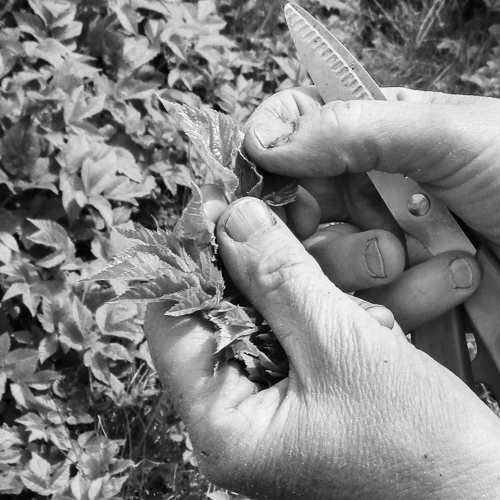I went to a course on wild, edible plants in May last year, but I never got around to start collecting and eating them. However, I saw that Rita Amundsen was going to hold a similar course, and having known her exceptional capabilities as a herbalist for several years, I knew that it would be a good course.
After the microgreens course, I’ve been thinking about buying a small growth system in order to grow vegetables in my apartment, but after another course on wild, edible plants, I have changed my mind. Why spend money on a growth system when you can collect edible plants outside for free? Besides, they are robust and nobody is spraying them. Since we have a wet and cold spring in Norway, even plants inside greenhouses grow slowly, while wild plants seemingly don’t notice that they should do the same. Having been here since the last ice age about 10.000 years ago, they have adapted to our unpredictable weather.
Having introduced ourselves, we went just outside the property of the Amundsen family in order to collect plants like ground elder, common nettle, ground-ivy, Turkish wartycabbage and garlic mustard, while inside the garden Rita had planted ramson, which we also collected. In addition, she had collected seeds of elm, rowan leaves, dandelion and meadowsweet/meadow wort beforehand.
After having finished collecting, we entered the living room and sat around a table. Next, Rita put some herbs she had collected in a jar and poured water into it. She also passed around a tray with herbs, which we were asked to put in a cup and pour boiling water into it. After waiting for some minutes, all of us could enjoy fresh, herbal tea. She told us that we should start collecting only a few plants and know as many recipes as possible and gradually increasing our range of edible weeds. Or, as I would have preferred, just do whatever you want without using any recipe. She let us know about ways of preservation like drying, making lemonades and deep-freezing. She highly recommended labelling the jars before storing them. Next, she read aloud tasks to be done, ranging from making pancakes and omelettes to herbal butter, frying dandelions and many other courses. I selected making herbal butter, which consisted of chopping herbs into small pieces, putting them in a bowl with butter and mixing everything by means of a fork.
Finally, we had a tasty, delicious and wholesome meal together. Rita told us that she’s only using weeds for food and not medicine, but she referred us to Rolv Hjlemstad, maybe our country’s foremost expert on medicinal use of weeds.
After having finished the course, I’ve started looking for edible weeds, in particular common nettle, because it’s so easy to recognise. Having been burnt by this plant many times, I’ve always avoided them, but now I want to eat them instead!

